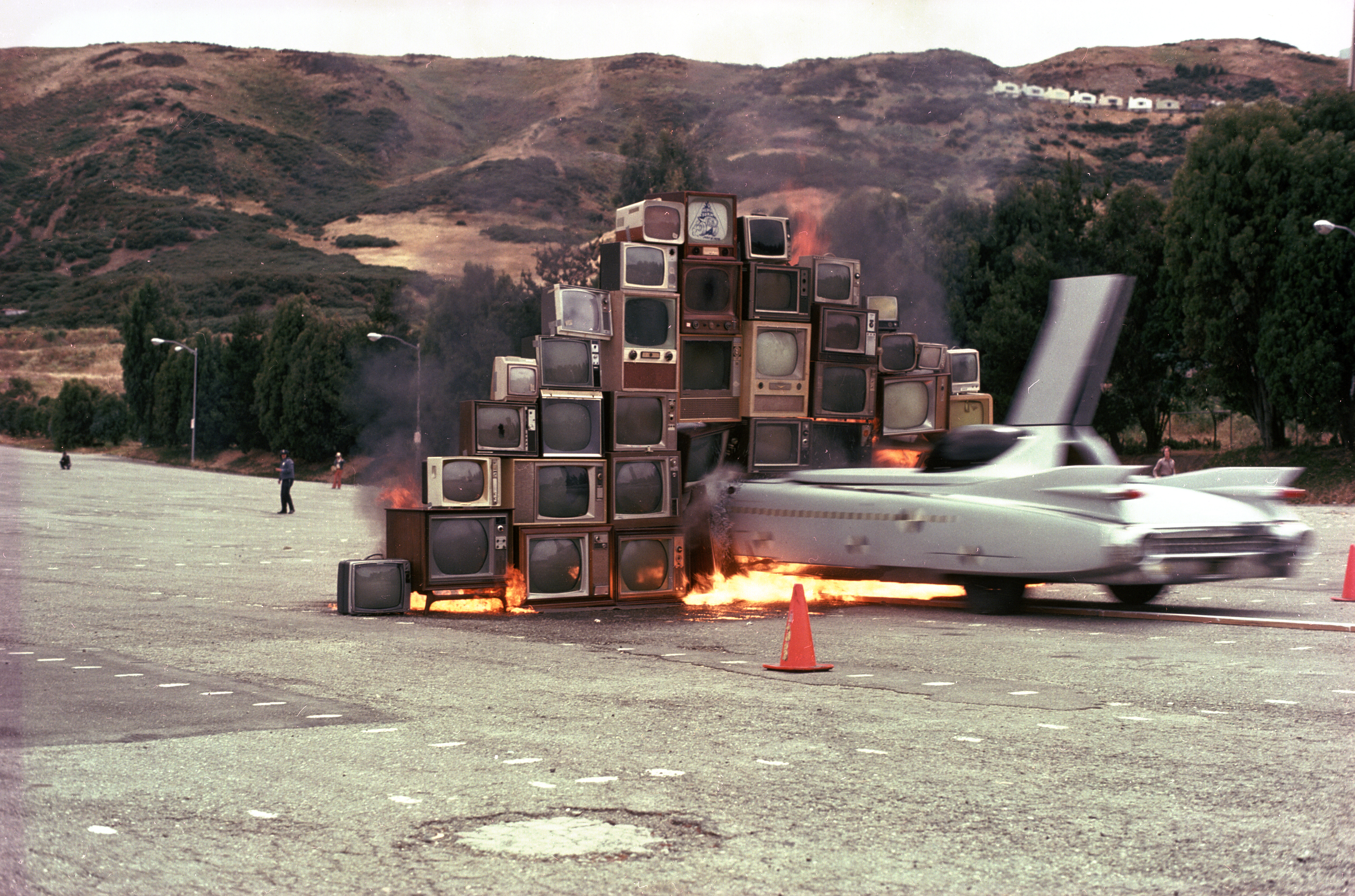Hammer Museum to screen ‘Space, Land and Time’ documenting works of art-and-architecture collective Ant Farm

In Ant Farm’s 1975 video art piece, “Media Burn,” the group’s members drive a Cadillac into a wall of burning televisions. “Space, Land, and Time: Underground Adventures with Ant Farm” will be featured Wednesday night at the Hammer Museum.
Credits: HAMMER MUSEUM
Space, land and time: Underground adventures with Ant Farm
Wednesday night, 7 p.m.
Hammer Museum, FREE
By Elisa Mosler
Nov. 9, 2010 1:15 a.m.
Students who want to see cars driving through burning technology, wacky reenactments of JFK’s assassination, and giant inflatable installations need not look further than Westwood’s own Hammer Museum on Wednesday night.
At 7 p.m. the museum will show “Space, Land and Time,” a new film documenting the radical-art-and-architecture collective Ant Farm. The free screening of the film, co-directed by Laura Harrison and Beth Federici, will be followed by a discussion with Ant Farm’s co-founder, Chip Lord.
Ant Farm was founded in 1968 in San Francisco by Chip Lord and UCLA alumnus Doug Michels, who set out to make “underground architecture” to counter the architectural mainstream. The multi-disciplinary group produced work that challenged accepted boundaries of art, while providing a sharp cultural commentary for its spectators. At a time of widespread social and cultural revolution, Ant Farm added its subversive yet playful voice to society through architecture.
“I think that their mission was to take architecture out of its very reductive, brutalist, concrete, grid-like world and try to explore other ways that you can express architecture ““ to break out of the confines that architecture school was putting on students and their career trajectories at that time,” Federici said.
Most famous for “Cadillac Ranch” (1974), the iconic series of upturned Cadillacs wedged in Texan wheatfields, Ant Farm also produced much performance, installation and video art, as well as numerous architectural commissions in the U.S. Its 26-minute video “Media Burn” (1975), in which the group’s members drive a Cadillac into a wall of burning televisions, has become a much-studied classic in video art.
Harrison and Federici learned about Ant Farm while studying art history as undergraduates. An encounter with the late Doug Michels inspired them to collaborate on what was originally going to be a shorter film focused on one of Ant Farm’s works, “Film Capsule.” But as Harrison and Federici learned more about what the group had done, they eventually decided to create a full-length documentary about the collective.
“Space, Land and Time: Underground Adventures with Ant Farm” compiles interviews, archival video, unseen footage of the group’s work, new animations and stills.
“It was really a process of discovery,” Harrison said. “We began to see the bigger picture; there was a lot of learning on the way. (We created) something that was worthy of them and that could also stand alone as a creative piece. Members of Ant Farm were happy with the result.”
One theme developed in Ant Farm’s body of work, and explored in the film, is the rise of mass media and television and their accompanying dangers ““ topics even more relevant today. Ant Farm traveled through the U.S. in its “Media Van,” a Chevrolet van that acted as an on-the-go studio for the group, which used it to share information with the public as it toured.
“People don’t understand what a radical, futuristic concept (the “Media Van”) was. They were so prescient. They were just so ahead of the game. (They thought) technology would catch up to their vision, and it has,” Federici said.
Another characteristic that set the group apart was its multi-disciplinary approach.
“(Ant Farm was) so diverse in their enterprise, and their work spans so many different realms. It was always more about the idea than how to execute it,” Harrison said.
A strong emphasis on spectacle and audience participation made Ant Farm’s work accessible to the wider public and allowed it to disseminate its message.
“I think that they were really inspirational. Their attitude was, “˜We’re not doing this for the art world, we’re doing this for the public,'” Federici said.
Ant Farm forged a significant link between protest and architecture, with an effort to provoke audiences to question aspects of society, including mass media. Ryan Peeters, a first-year architecture graduate student, said he firmly believes in the ability of architecture specifically, to generate social change.
“(It can do this by) creating trends and sending a message through something that’s different and individual in the context they work in. Even though it obviously takes a lot more time to produce something, architecture can have more of a dynamic impression than traditional visual art,” Peeters said.


